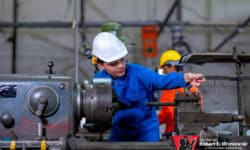Don’t miss out on the compensation you deserve after a welding injury
According to the U.S. Bureau of Labor Statistics (BLS), there are nearly 5,500 people working as welders, cutters, and solderers in the state of Arizona. It can be a lucrative career for the top earners in the field: They take home more than $30 per hour.
A career in welding, however, isn’t without risks. Workplace accidents can run the gamut, from burns and shocks to lung, eye and skin cancers. Additionally, those who find themselves injured on the job might face difficulty filing a workers’ compensation claim and receiving their benefits.
This guide will give you an overview of everything you need to know about welding accidents in Arizona and how to receive worker’s compensation after an injury.
Main responsibilities and job duties of welders
Welding is a fabrication job that involves fusing or melting materials together. These materials are usually metals, though some welders work with thermoplastics, too.
Welders use many different tools and techniques on the job. Some even choose to specialize in a particular methodology, so you’ll have those who are experts in arc welding, laser welding and more.
Regardless of the method, all welding work essentially boils down to heating materials and joining them together.
Which industries do welders typically work in?
Welders are employed in a variety of industries, most of them industrial.
The biggest field for welders is manufacturing, which employs 64% of welders in factories and warehouses across the U.S.
Other industries for welders include construction, contracting, repair and maintenance. There are also welders in specialty fields such as car racing and shipbuilding.
Common occupational injuries and illnesses for welders
Welding accidents can happen even under the best of circumstances, and the risks get worse when you add in deadline pressures, cut corners, a lack of personal protective equipment (PPE), or a lack of training for employees.
Here are just a few ways that welders can get hurt on the job:
- Respiratory issues. Welders are exposed to a number of harmful fumes during their work, which can lead to lung disease, irritant-induced asthma, and chronic obstructive pulmonary disease (COPD). There’s even a condition known as “welder’s lung,” which results from the inhalation of metal fumes and gasses produced during welding processes, particularly when welding certain metals like zinc, aluminum, copper, and steel. The condition causes inflammation in the lungs, leading to symptoms such as coughing, shortness of breath, fever and generalized fatigue.
- Flash burns. A flash burn is caused by ultraviolet light exposure from welding tools or processes. It affects the eyes, essentially giving the corneas a sunburn. The severity can range from mild to debilitating.
- Hearing loss. Welding equipment can be noisy, especially in an environment where other fabrication processes are also taking place. Short- or long-term hearing loss is a common consequence.
- Cancer. Lung cancer is the most frequent cancer among welders. Eye cancers and skin cancers can also occur.
- Death from asphyxiation. While rare, this can occur if a worker is welding in an unventilated or confined space.
Guide to Arizona Workers’ Rights When Injured on the Job
Learn about your right to compensation after a work-related injury or illness in Phoenix.
Common causes of welding injuries
Welding is an inherently risky job that often results in injuries to workers, even when proper precautions are taken. What causes these injuries? The most common causes include:
- Exposure to fumes and toxic gasses
- Electric shocks
- Fires
- Explosions
- Faulty equipment
- Lack of training
- Lack of protective gear
In the news:
Texas crude oil explosion
In 2016, the Sunoco Nederland oil terminal in Texas made headlines after an explosion caused worker injuries. It happened due to a welding accident. When a contractor was welding pipe segments full of residual crude oil, the oil caught fire, overpressurizing the pipe and causing it to eject burning oil and fragments from both ends.
The incident hurt a total of 7 workers. An investigation by the U.S. Chemical Safety and Hazard Investigation Board (CSB) cited a lack of adequate guidance by Sunoco and its contracting company, L-Con.
Are injured welders entitled to workers’ comp in Arizona?
Most employers in Arizona with even 1 employee are required by law to offer workers’ compensation.
There are exceptions, however, such as if they employ independent contractors or casual employees or are considered sole proprietors of their businesses.
What types of injuries and illnesses are covered under workers’ comp?
In Arizona, workers’ compensation covers both one-time injuries and occupational illnesses, like COPD or cancer, that develop over time. In many cases, it even covers pre-existing conditions that are worsened by the job.
In other words, you don’t have to have a welding “accident” to seek workers’ comp. As long as your condition was caused or exacerbated by your welding job, you should be entitled to benefits.
Types of compensation available through Arizona workers’ comp
Workers’ compensation benefits only cover “economic damages,” or damages that can be calculated with numbers and formulas. They don’t cover “non-economic damages,” such as pain and suffering.
As for the economic damages that you can receive from workers’ comp in Arizona, here are the 3 main categories:
- Medical benefits. These include hospital bills, prescriptions, doctor bills, support devices, occupational and physical therapy, and mileage reimbursement for medical appointments.
- Lost wage benefits. These are typically two-thirds of your average weekly wage for a period of time that depends on your disability (temporary partial disability, temporary total disability, permanent partial disability, permanent total disability).
- Death benefits. These cover funeral expenses and lost income if a loved one dies on the job.
What steps do workers need to take after an injury to file a workers’ comp claim in Arizona?
It’s important to act fast after suffering a welding accident in Arizona. There are specific steps you need to take to apply for workers’ comp, and you’ll need to do them in order:
- Seek medical attention to document your injury and prevent it from getting worse.
- Notify your employer of your injury, preferably in writing.
- File a claim within 1 year by filling out either a “Worker’s Report of Injury” or a “Worker’s and Physician’s Report of Injury” form.
- Wait for your employer’s insurance company to approve or deny your claim. (You typically hear back within 3 weeks.)
- Contact an attorney for help filing an appeal if your claim is denied. You must file an appeal within 90 days.
Arizona Workers’ Compensation Forms
Look no further! Here’s a complete list of the necessary forms for filing a workers’ comp claim in Arizona.
How can welding accidents be prevented?
Safety is paramount for industrial workers of all types, including welders. Here are just a few key elements to avoid injury and illness on the job:
- Adequate training. All welders should receive proper training and certification before starting work. Training should cover safe welding techniques, equipment operation and hazard awareness.
- Personal protective equipment (PPE). PPE should always be worn while welding. This includes welding helmets with auto-darkening lenses, flame-resistant clothing, gloves and respiratory protection to prevent inhalation of fumes.
- Monitor exposure levels. Regularly monitor air quality to assess welding fume levels in the workspace and make adjustments as needed.
- Fire prevention. Keep the work area clear of flammable materials, and have fire extinguishers readily available. Regularly inspect welding equipment for any signs of malfunction that could lead to sparks or fires.
- Safe welding practices. Follow established safety guidelines for welding techniques and equipment setup. Avoid shortcuts and take time to set up the workspace properly to minimize the risk of accidents.
- Pre-work inspections. Regularly inspect welding equipment and tools before each use to ensure they are in good working condition. Address any issues or malfunctions promptly.
- Proper ventilation. Maintain well-ventilated work areas to reduce the concentration of welding fumes and gasses. Local exhaust ventilation systems can effectively capture and remove welding fumes at the source.
- Supervision and communication. Provide adequate supervision and clear communication between workers to ensure everyone is aware of potential hazards and safety protocols.
- Ongoing training and refresher courses. Conduct periodic safety training and refresher courses to reinforce safe practices and keep workers updated on the latest safety standards.
By prioritizing safety, providing adequate training, and implementing preventive measures, welding accidents can be significantly reduced, creating a safer working environment for welders and others in the vicinity.
Contact an experienced Arizona work injury attorney
Welding-related injuries and illnesses are often severe, requiring extensive medical care and lifelong accommodations. Furthermore, those suffering from an occupational illness like cancer often have a difficult time proving their illness is work-related. Whatever you do, don’t let an initial denial of your claim deter you from pursuing the compensation you deserve.
At the Law Offices of Robert E. Wisniewski, we’ve been helping injured Arizona workers get maximum compensation for their claims for more than 45 years. Let us handle the negotiations with the insurance company so you can focus all of your energy on your recovery.
Contact us today for your free consultation.





